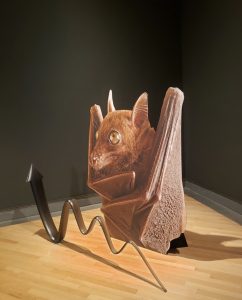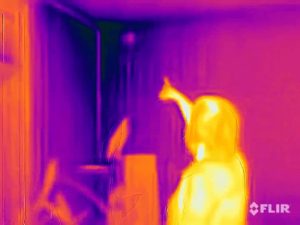Previously: Hello Process! (El proceso como paradigma – Process Becomes Paradigm)
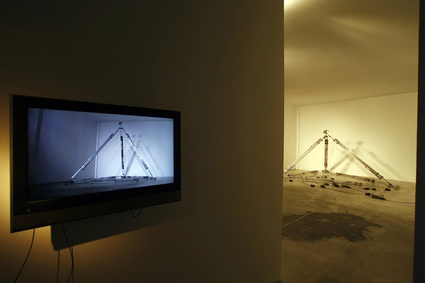 Leo Peschta, Der Zermesser, 2007 (image courtesy laboral)
Leo Peschta, Der Zermesser, 2007 (image courtesy laboral)
Laboral‘s new exhibition, El proceso como paradigma – Process Becomes Paradigm reflects the shift in contemporary art and culture from finished, stable objects to processes. Flourishing beyond the limits imposed by the market, this is art in continuous flux and execution, that has a life of its own, that grows, changes and decays. Curated by Susanne Jaschko and Lucas Evers, El proceso como paradigma invites visitors to come back once or twice over the course of this 5 month exhibition in order to see how the works have degenerated, grown or simply evolved over time.
El proceso como paradigma is the first exhibition i have visited that had to face the chaos and hardships brought about by the eruption of that Icelandic volcano with an impossible name. Some artists couldn’t attend the opening, others drove hundreds of kilometers in a car to transport their work to Gijón, some material arrived at the last minute. This adverse situation echoes only too well the underlying topic of the show. El proceso como paradigma reflects the globalized, complex world in crisis we live in. The curators quote Baudrillard who, in Impossible Exchange, wrote, “The irruption of radical uncertainty in all fields and the end of the end of the comforting universe of determinacy is not at all a negative fate, so long as uncertainty itself becomes the new rule of the game. So long as we do not seek to correct that uncertainty, by injecting new values, new certainties, but have it circulate as the basic rule.”
El proceso como paradigma navigates the area that separates predictability and stability from their complete yet manageable antithesis.
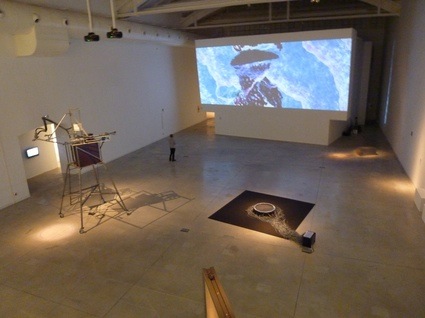
The exhibition is articulated over 6 chapters. One of the most spectacular is The Autonomous Automat: Beyond the Newtonian machine. The works in this section tirelessly perform the same task. They are imbued with an almost neurotic behaviour that recalls some of J/G. Ballard’s dystopian short stories.
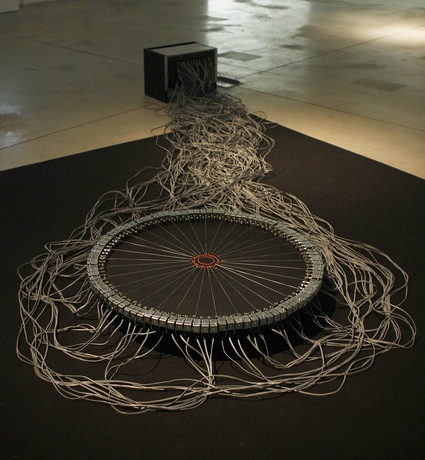 Ralf Baecker, The conversation, 2009. Image courtesy Laboral
Ralf Baecker, The conversation, 2009. Image courtesy Laboral
I had already been swooning over one of Ralf Baecker‘s previous pieces, Rechnender Raum (Calculating Space), a few months ago at the Share festival in Turin. The work he is showing at Laboral doesn’t disappoint.
Part of a series of works that deconstruct the fundamentals of symbolic processes, The Conversation incorporates an analogous and a digital part that strive to adapt to each other. As the process does not have a linear program it is not obvious which part controls whom.
99 solenoids mounted in a circle carry three rubber bands (an office staple that acts here as attractors) in their center. Each magnet works autonomously and tries to adapt to the forces in the network. The aim of the system is to keep a balance of forces. By turning the machine on, a process is activated that tries to conserve its initial state by contraction and relaxation. The rubber band acts as mediator between the single solenoids. Different initial rubber-band configurations (tensions) generate different patterns in time. Constellations appear and stay until disturbances make them decay. The whole installation is immersed in a polyphonic buzz generated by the constant shifting forces of the solenoid array. The Conversation is part of a series of installations and sculptures that deconstruct the fundamentals of symbolic processes.
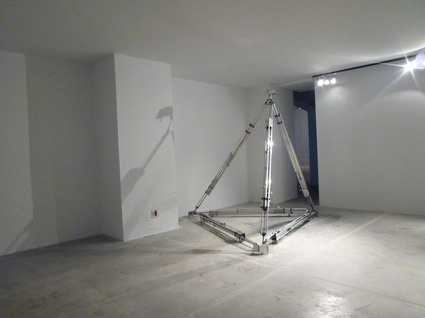 Leo Peschta, Der Zermesser, 2007
Leo Peschta, Der Zermesser, 2007
Leo Peschta‘s Der Zermesser is an innerving and puzzling tetrahedron that is constantly searching for a way to fit its own form into the surroundings space. Each of its sides and each corners are autonomous entities that constantly communicate with each other. The four corners are capable of recognising when the object reaches the borders of the space and the six sides can control their own length and thereby change the shape of the whole object, enabling the object to move freely within the space by changing its centre of gravity and its dispersion. Der Zermesser is a pitiful creature, always on the lookout for a balance and a place it will probably never encounter. Video.
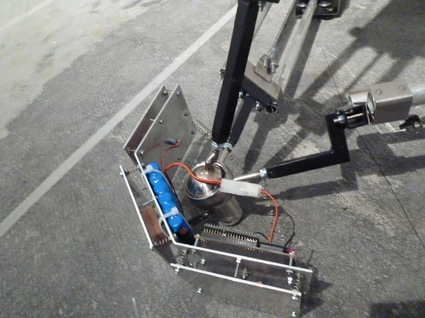 Leo Peschta, Der Zermesser, 2007 (detail)
Leo Peschta, Der Zermesser, 2007 (detail)
And then there is 400s, a machine-sculpture is specially made for the exhibition. I was glad to see that Henrik Menné (whose work i knew so far through a machine spitting glue) had lost nothing of his taste for the absurd and the obsessive.
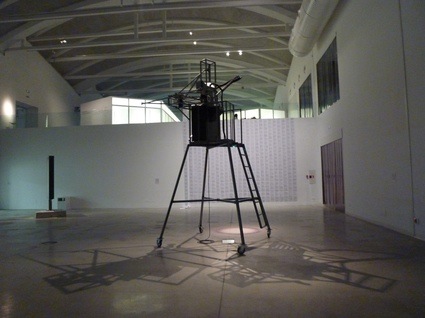 Henrik Menné, 400s, 2010
Henrik Menné, 400s, 2010
Over the course of the whole exhibition, 400S is patiently producing two large-scale stearin cylinder shaped objects. They will be approximately three metres high and 1,30 metres in diameter. Although closed and controlled, the system changes its immediate environment almost as much as it is sensible to the changes in the environment. The instability of the physical context is indeed what causes variations in the shapes of the slowly rising cylinders.
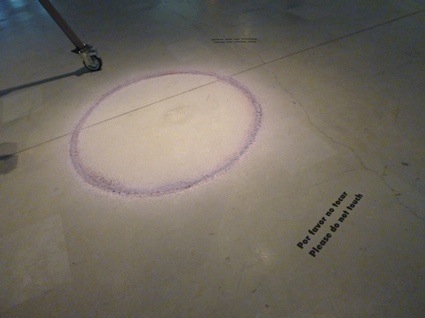 Henrik Menné, 400s, 2010 (detail)
Henrik Menné, 400s, 2010 (detail)
El proceso como paradigma – Process Becomes Paradigm is on view at Laboral Art and Industrial Creation Centre in Gijón until August 30, 2010.



